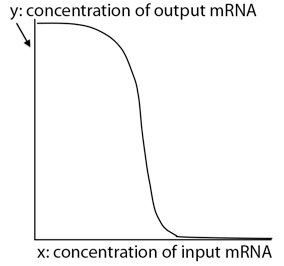
Biochemical inverter
Let us consider a simple electronic NOT gate, or an inverter, if it has an input of a voltage higher than a preset threshold, its output will switch to a low voltage in response and vice versa. Similarly, if we need to construct a biochemical inverter embedded in the genes of E. coli, then we may engineer it in a way that the input signal, which is the concentration of input mRNA, determines the output, which is the corresponding concentration of another type of mRNA.
Using what we have learnt, we can now discuss the biochemical inverter we just proposed in a greater detail. To begin with, the mRNA is translated into a polypeptide chain, which is then folded into a 3-dimensional protein. This protein works as a repressor, binds an operator on a specific operon, therefore preventing the transcription of gene into the output mRNA. On the other hand, without the presence of input mRNA, namely consequently the repressor protein is absent, the gene can be transcribed into the output mRNA. (see figure above) The steady-state relation between the relative concentrations of input and output mRNA can be roughly estimated as illustrated below -

flickr - Gaetan Lee
References
1 Large-volume transformation with high-throughput efficiency chemically competent cells. Focus 20:2 (1998)
